Charaka Samhita Sutrasthana Chapter 1 – Quest For Longevity
Today, we are starting to learn Charaka Samhita – chapter by chapter. It is the number one authority book on Ayurveda. It was first composed by Agnivesha, further developed by Charaka and enriched by Dridabala. The first part of Charaka Samhita is called Sutrasthana, Sutra means formula / basic principles. All the chapters will be available under the category of ‘Textbooks’ in this website (see right column). The numbers in the bracket indicate the number of Sanskrit verses of the chapter. If you get any doubts on any topics, just leave a comment below the article. I will try to make it easy.
The first chapter in Sutrasthana is Deergham Jeeviteeya Adhyaya – quest for longevity.
First Chapter
We shall now expound the Chapter on “The Quest for Longevity.” Thus said Lord Atreya [ 1-2 ]
Table of Contents
Origin of Ayurveda
Lord Brahma recollected the knowledge of Ayurveda and passed it on to Daksha Prajapati. From him, the sacred knowledge of Ayurveda was passed on to Ashwini Kumaras (Ashwini twins who are considered as doctors for Devatas (divine souls). From them, Lord Indra learnt Ayurveda.
Saint Bharadwaja, being desirous of long life, having known about Indra, approached Indra and learnt about Ayurveda. [3-5]
List of sages in Himalayas
In ancient times, sages were desirous of having a long life so that they can perform religious practices, Brahmacharya, sacred studies, Upavasa (fasting), Yama and Niyama (rules of auspicious living), Homa etc spiritual activities. The sages also wanted to help the people by relieving their diseases. With this agenda, the Sages sat together in the Himalayas. Those sages included Angeerasa, Jamadagni, Vasistha, Kashyapa, Bhrugu, Atreya, Gautama, Sankhya, Pulastya, Naarada, Asita, Agastya, Vamadeva, Markandeya, Ashvalayana, Parikshi, Bhiksu, Atreya, Bharadvaja, Kapinjala, Vishvamitra, Ashmarathya, Bhargava, Chyavana (after whom Chyavanprash is named), Abhijit, Gargya, Shandilya, Kaundilya, Varkshi, Devala, Galava, Sankrutya, Baijavapi, Kushika, Badarayana, Badisha, Saraloman, Kapya, Katyayana, Kankayana (after whom Kankayana vati tablet is named), Kaikasheya, Dhaumya, Maricha, Kashyapa, Sharkaraksha, Hiranyaksha, Lokaksha, Paingi, Shaunaka Shakuneya, Maitreya, Maimatayani, Vaikhanasas and Valakhilyas. [ 6 – 14 ]
During the conference
During the conference, they learnt that knowledge and practice of Ayurveda only can save lives and help them to attain longevity.
Good health stands at the very root of
Dharma – righteousness, virtuous acts,
Artha – acquirement of wealth and prosperity,
Kama – fulfilling desires
Moksha – Renunciation.
Diseases are destroyers of health, well being and life. This has manifested as a great obstacle in the way of human life. What could be its remedy? – With this point in view, the sages entered into meditation. In their spiritual vision, they found a saviour in Lord Indra; and got an assurance that he – the Lord of the Gods would explain the proper way to counteract diseases. They decided to send Sage Bharadwaja to Lord Indra to learn Ayurveda from him. Accordingly, he went to Indra’s abode and saw Indra, the destroyer of Bala sitting in the midst of the gods and sages and glittering like fire. [15-17]
Bharadwaja’s plea
Bharadwaja pleaded – “The diseases are terrifying all living beings and have manifested themselves. Advise me as to their proper remedial measures, O Lord!” Then lord Indra, considering the latter’s depth of wisdom, expounded the science of life to the sage in brief. [18 – 23]
Bharadwaja learnt Ayurveda and preached this noble science in this world. From him, Atreya Punarvasu learnt it and then Agnivesha etc sages learnt it. Lord Agnivesha went on to write Charaka Samhita, which was later refined by Charaka and Drudabala.

Trisutra
Indra expounded the immortal and sacred science of life (Ayurveda) consisting of three principles viz.,
Hetu – causative factors of disease
Linga – symptomatology
Aushadha Jnana – knowledge of therapeutics, treatments and medicines. [24]
Hetu, Linga and Aushadha are known as Trisutra – the three formulas of treating disease.
Bharadwaja – the sage of great wisdom and devotion, enjoyed an infinitely long and happy life, and passed on his sacred knowledge of Ayurveda to other sages. [ 25 – 26 ]
Shat Padartha
These sages duly visualised by force of their intuitive powers
Samanya (common),
Vishesha (speciality),
Guna (qualities),
Dravya (substance),
Karma (action) and
Samavaya (inseparable).
These are the various categories as enumerated in the Nyaya system of philosophy. After having known all this, the sages acted on the prescriptions as available in science and attended to the highest well-being and an inexhaustibly long life. [ 27 – 29 ]
Atreya’s students
Then Atreya Punarvasu, friendly to all and having compassion for all taught Ayurveda to his six disciples – Agnivesha, Bhela, Jatukarna, Parashara, Harita and Ksharapani. [ 30 – 31 ]
Expounding of Samhitas
Then the wise ones like Bhela and others expounded their respective works and presented them to Atreya accompanied by a group of sages. Having heard the exposition of science by the holy ones – disciples of Atreya, the sages were extremely delighted to find that the exposition was well done and they welcomed it. All of them admired these disciples of Punarvasu who were desirous of doing good to all creatures and they all at a time exclaimed loudly, “Brilliant is this sympathy for living beings!”.
The divine sages accompanied by the Gods residing in heaven heard this sacred word of great sages and were extremely delighted to hear this. “Oh! Excellent,” this deep and melodious sound produced in heaven by the delighted gods resounded the three worlds. The auspicious wind blew and all directions were illuminated by divine light. Divine showers of flowers and water dropped down and then the gods of wisdom viz. Intellect, Accomplishment, Memory, Understanding, Patience, Fame, Forbearance, and Pity entered Agnivesha and other disciples and these works, accepted by the great sages, were established on this Earth for the good of all creatures. [32-40]

Correction – 44th shloka, 2nd line – hrasa (not halasa).
Definition of Ayurveda
Ayurveda is the science of life which explains about remedies for
Hitayu – advantageous life
Ahita Ayu – disadvantageous life
Sukhayu – happy state of health and mind
Ahitayu – unhappy state of health and mind.
It also explains what is good and bad for life and measurement of life [41]
Definition of Ayu (life)
The term ‘Ayus’ stands for the combination of
Shareera – body,
Indriya – sense organs,
Satva – mind and
Atma – soul.
This means that when the body is intact with sense organs, mind and soul, then one has life. Otherwise not.
Synonyms of life
Synonyms of life are
Dhari – the one that prevents the body from decay,
Jeevita – which keeps alive,
Nityaga which keeps the soul, mind and sense intact with the body all the time, without discontinuation and
Anubandha which transmigrates from one body to another (after death). [42]
As it is beneficial to mankind in respect of both the worlds i.e. this life and the life beyond, Ayurveda, the most sacred and honoured by those proficient in the Vedas will now be expounded. [43]
Theory of similarity and difference
Common features and characteristics lead to growth. For example, Kapha dosha has oiliness. If we eat oily food, Kapha dosha increases in the body.
Difference or specialities in characteristics lead to division and degeneration or depletion. [44 – 45]. For example, dryness is opposite to Kapha Dosha. If we eat foods that are dry in nature, it decreases Kapha Dosha.

Tridanda
Satva (Mind), Atma (soul) and Shareera (body) – these three are the Tripods of life. The world is sustained by their combination; They constitute the basis for everything. [46-47]
Dravya – Basic matter
Five basic elements –
Prithvi – earth
Ap – water,
Tejas – fire,
Vayu – air and
Akasha – ether
Together with Atma (soul),
Mana (mind),
Kala (time) and
Disha (space) – these nine are basic matters.
The substances are of two categories –
Sa Indriya (Sendriya) – having sense organs and soul – living substances
Nirindryia Dravya – which do not have sense organs and soul – non living substances. [48]
Guna – qualities
They are – 5 Sartha Gunas + 20 Guru adi gunas + Buddhi + 6 Prayatnadi Guna + 8 Paradi Gunas are the total qualities.
5 Objects of sense organs
Shabda (sound perceived by ears),
Sparsha (touch perceived by skin),
Roopa (shape perceived by eyes),
Rasa (taste perceived by tongue) and
Gandha (smell perceived by nose)
20 Guru adi gunas
Guru (heavy) X laghu (light)
Manda (slow) X tiksna (quick, fast)
Hima (cold) X ushna (hot)
Snigdha (unctuous) X ruksa (dry)
Slaksna (smooth) X khara (rough)
Sandra (solid) X drava (liquid)
Mrdu (soft) X kathina (hard)
Sthira (stable) X cala (moving, unstable)
Suksma (stable, small) X sthula (big, gross)
Vishada (non slimy) X picchila (slimy)
Knowledge
Knowledge which includes
Smriti (recollection),
Chetana (living),
Dhriti (intelligence),
Ahamkara (ego).
6 Qualities of Atma (soul)
Iccha – desire,
Dvesha – hatred,
Sukha – comfort, happiness,
Dukha – grief,
Buddhi – intellect,
Prayatna – effort.
Paradi gunas
Para – great,
Apara – not great,
Yukti – planning,
Samkhya – number,
Samyoga – combination,
Vibhaga – division,
Pruthaktva – individuality,
Parimana – quantity,
Samskara – processing,
Abhyasa – habituation
All these together constitute qualities. [49]
Definition of Karma
The act done with effort is called action (Karma). [49]
Samavaya
Samavaya means an inseparable relationship. Such a relationship exists between
Prithvi and Gandha (earth and smell),
Ap and Rasa (water and taste),
Tejas and Rupa (Fire and shape),
Vayu and Sparsha (Air and touch),
Akasha and Shabda (Ether and sound).
This is eternal because where there is matter, its distinctive quality is always there. [50]
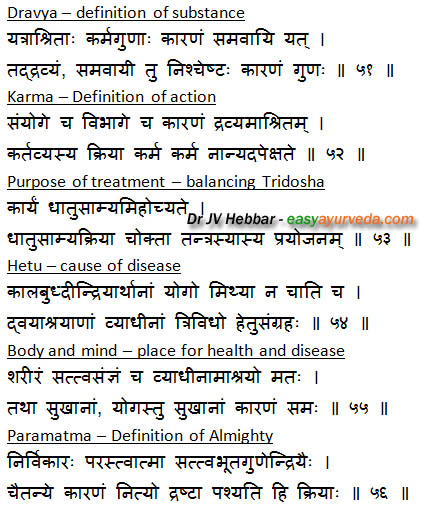
Definition of Dravya (matter)
The one having qualities (Guna) and action (Karma) in an inseparable relation is called matter (Dravya). [51] For example, ghee (matter) has oiliness (quality) and decreases Vata (action).
Definition of qualities (Guna)
That which has inseparable relationship with matter but does not have its own action, is called Guna. [51]
For example, the oiliness (quality) in ghee (matter) lives inseparably. But oil itself does not have any action. The Vata decreasing action is done by the ghee (matter).
Definition of Karma (action)
That which lives inseparably with the matter (Dravya), which causes combination and separation is called Karma. Karma makes the matter act without depending on anything else. [52-53]
Karya – Aim of work
The aim of the work in Ayurveda is to bring balance to all the factors in the body (Dhatu Samya). Restoring this balance is the purpose of Ayurveda.
Cause for disease
The cause for the diseases related to both (mind and body) are
Atiyoga – excessive utilisation or indulgence
Heena Yoga – less utilisation or indulgence
Mithya Yoga – wrong utilisation of
Kala – time (like prolonged summer, short summer or heat of sun in other seasons),
Artha – objects of sense organs (smell, touch etc) (like excessive smelling, not at all seeing, or seeing in dark areas, looking at sharp objects etc)
and
Buddhi – mental faculties – like excess thinking, less thinking or wrong thinking and actions etc [54]
Sites of disease
Two places where disease occurs – The body and mind constitute the substrata of disease and happiness.
Balanced utilisation of time, mental faculties and object of sense organs is the cause for happiness. [55]
Definition of Atman (Soul / God)
Nirvikara – The soul is essentially devoid of all deformities.
He is the cause of consciousness through the mind and the specific qualities of basic elements (touch, shape, smell, taste and sound). He is eternal. He is an observer – he observes all activities. [56]
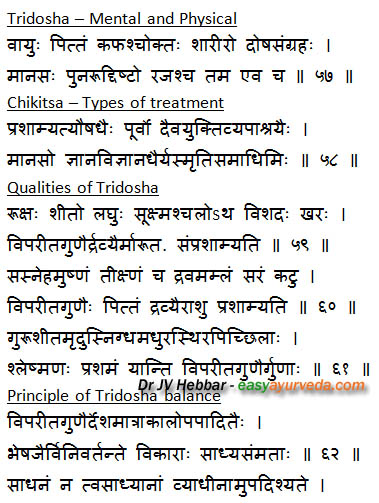
Physical and Mental Doshas, Treatments
Pathogenic factors in the body are Vayu (Vata), Pitta and Kapha.
Mental Doshas are Rajas and Tamas. [57]
Three types of treatments for these two types of Doshas –
The physical Doshas – Vata, Pitta and Kapha are balanced by
a. Daiva Vyapashraya Chikitsa – religious rites and
b. Yukti Vyapashraya Chikitsa – done by a physician with proper planning.
The psychological Doshas – Rajas and Tamas are balanced by spiritual and scriptural knowledge, patience, memory and meditation. These treatments help to win over the weakness of mind. Hence it is called Satva Avajaya Chikitsa [58]
Qualities of Vata Dosha
Rooksha (rough), Sheeta (cool), Laghu (light), Sookshma (subtle, minute), Chala – mobile, Vishada – clarity, non-slimy and Khara (coarse) are the qualities of Vata. It is balanced by medicines with opposite qualities.
Qualities of Pitta Dosha
Sneha (unctuous), Ushna (hot), Teekshna (sharp, piercing), Drava (liquid), Amla (sour), Sara (fluidity) and Katu (pungent) are Pitta’s qualities. It is balanced by medicines with opposite qualities.
Qualities of Kapha Dosha
Guru (heavy), Sheeta (cool), Mrudu (soft), Snigdha (unctuous, oily) Madhura (sweet), Sthira (immobile) and Picchila (slimy) [59-61]
Principle of Tridosha balance
The curable diseases are cured by medicines possessing opposite qualities, when administered with due regard to the place, dose and time. No medicine is to be prescribed for incurable diseases. [62-63]
And so Agnivesha will explain in detail the qualities and actions of drugs. [63]

Tastes
Taste – Ap (water) and Prithvi (earth) constitute the substratum for the manifestation of taste (Rasa). Taste is the object of tongue (Rasanendriya). Akahsa (ether), Vayu (air) and Tejas are responsible for the manifestation of different types of taste.
Sweet (Madhura),
Sour (Amla),
Salt (Lavana),
Katu (pungent),
Tikta (bitter) and
Kashaya (astringent) are the six types of Tastes. [65]
Medicines and food having sweet, sour and saline taste balance Vata;
Those having astringent, sweet and bitter tastes balance Pitta and
those having astringent, pungent and bitter tastes balance Kapha. [66]
Three types of medicines
Doshaprashamana – Which balances the increased Dosha.
Dhatu pradushana – Which imbalance the normal Doshas to abnormal stage
Swasthavrutta – which maintains the health in its normal state. [67]
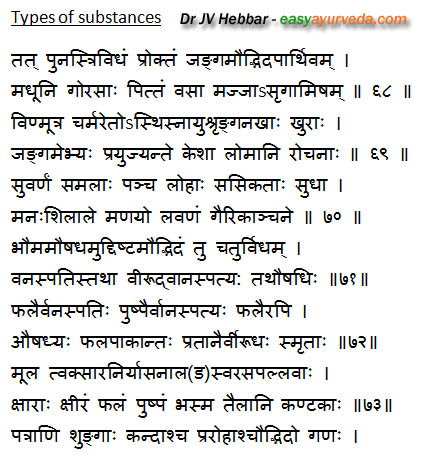
Another 3 types of substances (Dravya)
Jangama – those of animal origin. Example – Different types of honey, dairy products, bile, fats of muscle tissue, marrow, blood, flesh, faeces, urine, skin, semen, bone, ligament, horn, nail, hoof, hair, loma (hair of the body excluding those of the head and face), Gorochana (purified Ox bile) – these are some of the animal origin substances used in medicine.
Audbhida – those of vegetable origin.
Parthiva – metals including minerals which are obtained from underneath the ground. Gold, five Lohas (copper, silver, tin, lead and iron) along with their by-products (different types of bitumen), calcite along with silica, red arsenic, yellow arsenic, gems, salt, red chalk, collyrium – these are in brief the metals and minerals used in medicine.
Audbhida (plant source)
Audbhida (plant source) are further divided into four types –
Vanaspati – Having fruits without flowers
Vanaspatya – Having flowers and fruits.
Virudha – which spreads on ground, with branches.
Oshadhi – are those which die out when their fruits mature.
The root, bark, sara (aqueous extract), secretions, fibre, juice, tender leaves, alkali preparations, latex, fruits, flowers, ashes, oil, thorns, matured leaves, adventitious roots, rhizomes, sprouts – all these belong to the group of drugs of vegetable origin. [68-73]
As indicated by Atreya Punarvasu,
those having therapeutically useful roots are sixteen,
those having therapeutically useful fruits are nineteen,
important fats are four,
salts are five,
varieties of urine are eight,
milk is also eight.
Plants used for elimination therapy are six.
Only those who know how to apply these to various diseases really know the science. [74-76]
Those with therapeutically useful roots
Sixteen herbs having therapeutically useful roots are
Hastidanti (Croton oblongifolius Roxb.)
Haimavati (Vacha – Acorus Calamus Linn.),
Shyama – Shyama Trivrit (Operculina turpethum R.B. – black variety),
Trivrt (Operculina turpethum R.B. – white variety),
Adhoguda (?),
Saptala (Acacia concinna D.C.),
Svethanama (Clitoria ternatea Linn. – variety alba),
Pratyaksreni (Baliospermum montanum Muell. – Danti),
Gavakshi (Citrullus colocynthis Schrad.)
Jyotishmati (Celastrus paniculatus Willd),
Bimbi (Coccinia indica W. and A.),
Shanapuspi (Crotalaria verrucosa Linn.)
Vishanika (Helicteres isora Linn.),
Ajagandha (Gynandropsis gynandra Linn.),
Dravanti (Jatropha glandulifera Roxb.),
Ksheerini (Mimusops hexandra Roxb.).
Out of them, Shanapushpi (Crotalaria verrucosa Linn.), Bimbi (Coccinia indica W. and A.) and Haimavati (Acorus calamus Linn.) are used for emesis (vomiting treatment);
Shveta (Clitoria ternatea Linn.) and Jyotismati (Celastrus paniculatus Willd.) are used for the elimination (of Doshas) from the head and the remaining eleven are for purgation (Virechana).
Thus, the names and actions of plants having therapeutically most useful roots are described here. [77-80]
Those with therapeutically useful fruits
The plants having therapeutically most useful fruits are
Shankhini (Canscora decussate Roem. et. Sch.)
Vidanga (Embelia ribes Burm.),
Trapusha (Cucumis sativus Linn.),
Varieties of Madana (Randia dumetorum Lam.),
Dhamargava (Luffa cylindrica Linn. M. Roem.),
Ikshvaku (Lagenaria siceraria Standl.),
Jimuta (Luffa echinata Roxb.),
Kirtavedhana (Luffa acutangula Roxb.),
two types of Klitaka (Glycyrrhiza glabra Linn. ) – the one which grows in marshy land and the other which grows in dry land,
Prakirya (Caesalpinia crista Linn.),
Udakirya ( Pongamia pinnata Merr.),
Pratyakpuspa (Achyranthes aspera Linn.),
Abhaya (Terminalia chebula Linn.)
Antahkotarapuspi (Argyreia speciosa Sweet),
Autumnal fruit of Hastiparnini (?), fruit of Kampillaka (Mallotus philippinensis Muell. – Arg.) Aragvadha (Cassia fistula Linn.) and also of Kutaja (Holarrhena antidysenterica Wall.).
Dhamargava (Luffa cylindrica Linn. M. Roem.), Ikshvaku (Lagenaria siceraria Standl.), Jimuta (Luffa echinata Roxb.), Kritavedhana (Luffa acutangula Roxb.), Madana (Randia dumetorum Lam.), Kutaja (Holarrhena antidysenterica Wall.), Trapusa (Cucumis sativus Linn.), Hastiparnini (?) – all these are used in emesis (vamana) and also in Asthapana (a type of medicated enema).
Pratyakpuspa (Achyranthes aspera Linn.) is employed for elimination of Doshas by inhalation. Remaining ten are used for purgation treatment. Thus, the names and actions of nineteen plants having therapeutically most useful fruits have been described. [ 80-86]
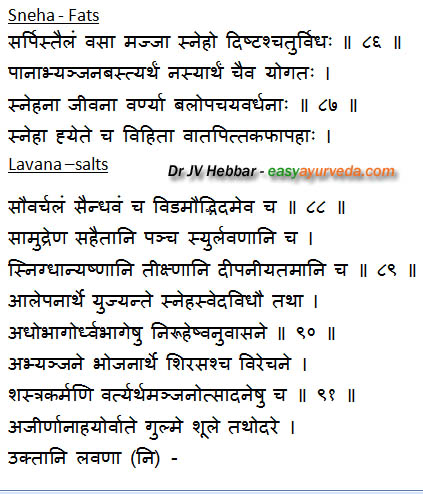
Four varieties of fats
Four varieties of fat are ghee, oil, muscle-fat and marrow. They are prescribed for internal use, massage, enema and inhalation. All these varieties of fat add to the unctuousness, invigoration, lustre, strength, corpulence (of the body) and alleviate Vata, Pitta and Kapha. [86-88]
Five varieties of salts
Five varieties of salt are Sauvarchala (sochal salt), Saindhava (rock salt), Vida (Ammonium chloride), Audbhida (salt from the earth), and Samudra (sea salt).
They are all unctuous, hot, sharp and most exceedingly appetising. They are also used for anointment, causing unctuousness, fomentation, purgation, emesis, Niruha, Anuvasana (types of enema – basti treatment), massage, intake, elimination (of Doshas) from the head, surgical measures, suppositories, collyrium, unction, and also for the correction of indigestion, constipation, treatment of diseases due to Vata, Gulma (abdominal tumour), Shoola (colic pain) and Udara (abdominal diseases including ascites). This is about salts. [88-92]
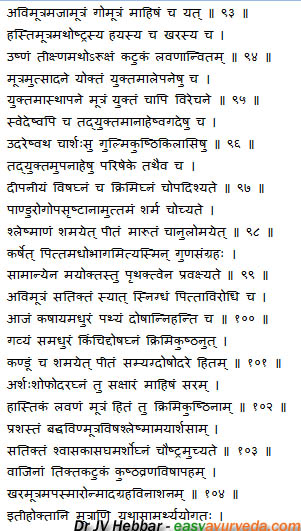
Mutra types, general qualities
The most useful varieties of urine as explained by Atreya, are eight, viz., urine of sheep, goat, cow, buffalo, elephant, camel, horse and ass.
General qualities of urine – They are hot, sharp, unctuous, pungent and salty. They are used for unction, anointment, Asthapana, purgation, fomentation, treatment of constipation, alleviation of diseases in general, Udara (diseases of abdomen including ascites), piles, Gulma (abdominal tumour), Kushta (skin diseases), Kilasa (a type of leucoderma), poultices. They are prescribed as appetisers, anti toxics and bactericides; They are also known as best remedies for those affected by Panduroga (anaemia). When taken internally, it alleviates Kapha and Vata and also brings down Pitta. These are the general properties (of urine), the specific ones are as follows:
Urine of sheep is bitter, unctuous, and not opposed to Pitta;
Urine of the goat is astringent, sweet, wholesome and balances all the three Doshas.
Cow urine is slightly sweet; it also alleviates Doshas; it is bactericidal; it cures Kustha (skin diseases). If taken internally, it alleviates itching. It is equally useful for the Doshas and Udara (abdominal diseases including ascites).
Buffalo urine is alkaline, laxative; it cures piles, Shopha (Oedema) and Udara (abdominal diseases including ascites).
Elephant urine is saline; it is useful against bacterial infection and Kustha (skin diseases); it is specifically useful in cases of constipation, dysuria, toxic conditions, diseases due to Kapha and piles.
Camel urine is bitter, it alleviates Shwasa (dyspnoea, asthma), Kasa (bronchitis, cough) and piles.
Horse urine is bitter and pungent; it cures Kustha (skin diseases), Vrana (ulcers) and toxic conditions.
Donkey urine cures epilepsy, insanity and Grahadosha (demoniac seizures).
Thus varieties of urine have been described keeping in view their potentiality and applicability. [92-105]
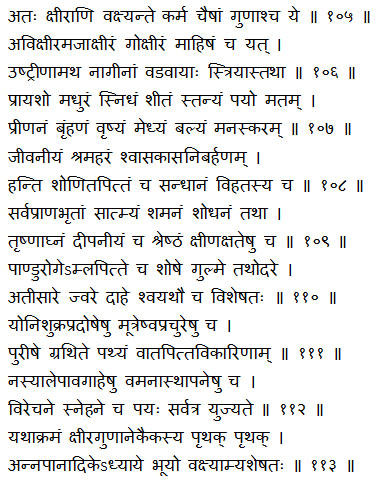
Milk types, properties
Milk – types and properties – sheep, she-goat, cow, she-buffalo, she-camel, she-elephant, mare and woman.
General qualities of milk – Milk is generally sweet, unctuous (oily), coolant, lactogenic, refreshing, nourishing, aphrodisiac, useful for improving intelligence, strength, useful for mental faculties, invigorating, fatigue-dispelling, reliever of dyspnoea and bronchitis; It cures Raktapitta (bleeding from different parts of the body) and helps healing of wounds. It is wholesome for all living beings, and alleviates and eliminates Doshas. It quenches thirst and is an appetiser.
It is extremely useful in Kshataksina (phthisis), Pandu (anaemia), Amlapitta (hyperacidity), Shosha (consumption), Gulma (abdominal tumour), Udara (abdominal diseases including ascites), Atisara (diarrhoea), Jwara (fever), Daha (burning sensation) and specially in Shvayathu (oedema). It is also useful in diseases of female genital tract, male reproductive fluid, depleted sperm count and hard stools. It is a wholesome diet for those suffering from Vata and Pitta imbalance disorders.
Milk is always used for inhalation, anointment, bathing, emesis, Asthapana (a type of medicated enema), purgation and function. We will explain in greater details the properties of milk separately one by one in the chapter Annapanadi (Sutrasthana 27th chapter). [105-113]
Three special herbs
Apart from the plants having most useful fruits and roots, there are three others viz.,
Snuhi (Euphorbia neriifolia Linn.),
Arka (Calotropis procera R. Br.) and
Ashmantaka (Ficus rumphii) whose actions are indicated separately (as follows).
Ashmantaka (Ficus rumphii) is useful for emesis, latex of Snuhi (Euphorbia neriifolia Linn.), for purgation; and that of Arka (Calotropis gigantia Linn.) for both emesis and purgation. [114-115]
Three trees with useful barks
There are three other trees whose barks are useful viz.,
Putika (Caesalpinia crista Linn.),
Krishnagandha (Drumstick – Moringa oleifera Lam.) and
Tilvaka (Symplocos racemosa Roxb.).
Putika (Caesalpinia crista Linn.) and Tilvaka (Symplocos racemosa Roxb.) are to be used for purgation.
Krishnagandha (Moringa oleifera Lam.) in Parisarpa (erysipelas), different types of Shotha (oedema), piles, ringworm, abscess, goitre and Alaji.
The wise should know all these six plants which are useful in elimination therapy.
Thus, the plants with most useful fruits and roots, varieties of fat, salt, urine and milk and also the plants having most useful latex and bark have been enumerated. [116-119]
The goatherds, shepherds, cowherds and other forest dwellers know the drugs by name and form. No one can know the principles governing correct application of drugs simply by knowing their names and forms. A physician, even ignorant of their forms can be said to be a knower of the essence [of this science] if he is acquainted with the principles of the correct application of drugs, let alone the one who knows drugs in their entirety. One who knows the principles of their correct application in consonance with the place, time and individual variation, should be regarded as the best physician. [120-123]
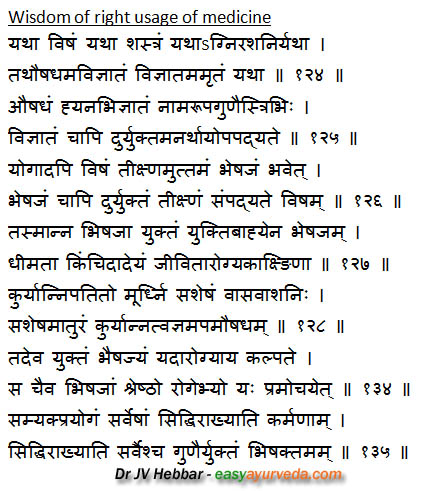
Wisdom of right usage of medicine
Poison, weapon, fire and thunderbolt if one does not know the proper use, it can kill him. Similarly, a medicine known in respect of its name, form and properties or even if known, improperly administered, leads to bad consequences. If known, the medicine acts as nectar. [124-125]
Even an acute poison can become an excellent drug if it is properly administered. On the other hand even a drug, if not properly administered, becomes an acute poison.
So a wise patient desirous of longevity and health should not accept any medicine prescribed by a physician ignorant of the principles governing its application.
Sometimes, one might escape death even when a thunderbolt of Indra has fallen on his head, but one can never survive if he takes medicine prescribed by a physician ignorant of the principles governing its application.
If the one pretending to be a wise physician, without knowing the principles governing its applicability, prescribes a medicine for a patient, distressed, lying on bed having faith (in the former’s prescription), he, the mischievous one is a sinner, devoid of virtuous acts, the messenger of death, even a talk with him will lead a man to hell.
One can take the poison of a serpent, melted copper; one can take iron-pills heated on fire, but the one (physician) wearing the garment of wise ones should not accept food, drink or wealth from a patient seeking his shelter. Thus, the wise one who aspires to be a physician should make special efforts to maintain his good qualities so that he can be the life-giver to human beings. [126-133]
Only that, which can bring about a cure, is a correct medicine. He who can relieve his patients of their ailments is the best physician. [134]
Accomplishment of all objects i.e. actual prevention and cure of diseases implies the proper application of medicine. Success also implies the presence of the best physician endowed with all good qualities. [135]
Summing up the contents
Thus the transmission of Ayurveda, object of transmission, spread, approval of the codification in a seminar, definition of Ayurveda, entire cause (means), object of Ayurveda, aetiology of diseases, enumeration of Doshas, collection of most useful medicines, enumeration of Rasas (tastes) along with their corresponding material objects, threefold classification of material objects, drugs, with most useful roots and fruits, important fats, varieties of useful salt, urine, and milk, those six plants whose latex and bark are most useful, actions of all these (drugs), their applicability and otherwise, good as well as bad qualities of theirs, abuse of physicians, the good qualities of physicians – all these have been explained by the sage in the first chapter. [136-140]
Thus ends the first chapter on “The Quest for Longevity” of the Sutra section of Agnivesa’s work as redacted by Charaka.
Copyright details – The Charaka Samhita Sanskrit version is open source. The meaning, interpretation as made above is the copyright of Dr JV Hebbar.











24 comments
rajendar menen
Very good!
Dr J V Hebbar MD(Ayu)Author
Thanks
monika kalra
Worth knowing about ayurveda. I too believe in ayurveda. Thanks for sharing your search. .
Dr J V Hebbar MD(Ayu)Author
Welcome.
jayaselvarlvaraj
Dear doctor,
Thank you so much for your sincere efforts and hard work to selflessly enlighten us. Sir, in your article, by saying ‘soul/God’, you seem to consider both to be the same. How can we souls be equal to God? Is soul not subservient and dependent on God? What is the opinion of Ayurvedic texts about it?
Dr J V Hebbar MD(Ayu)Author
I kept it subtle, but you noticed it. There are two versions in this. I will write about it in detail.
Dr J V Hebbar MD(Ayu)Author
I am glad you liked it. 🙂
suchi
Wonderful. Thanks for sharing
Dr J V Hebbar MD(Ayu)Author
welcome 🙂
santha
Very informative article, thank you for sharing.
dr nkp
your work is commendable… dont u think we are missing Sanskrit, and getting away from our heritage
Dr J V Hebbar MD(Ayu)Author
Dear Dr, True. But all that we can do is promote the ancient wisdom of Ayurveda in a language that is understood by common man.
tarun
Thanks doc. Hope you r able to translate Charak Sanhita fully as it’s a long book with two volumes.
Sirisha Ayyagari
Hello,
I want to take online Ayurveda course. Could you give me sugestions? Thank you very much for this book.
Dr J V Hebbar MD(Ayu)Author
It will be a paid service. Please write to me at – [email protected]
Monique
I managed to read it all. I can’t even imagine how long it wold take to learn it all. Only a brilliant mind. I like to keep reading, although difficult for me to understand, even bits and pieces interest me. I love everything ayurveda. Thanks and I will continue to read what you offer.
Ace
Very well written and informative .What books do you recommend for beginning readers of Ayurveda who want to read Sanskrit along with English text ? Also if one wants to read charaka samhita, could you pls suggest the author ?
Dr J V Hebbar MD(Ayu)Author
I have – Charaka samhita sutrasthana made easy – ebook – with Sanskrit and English translation – easyayurveda.com/2014/11/10/charaka-samhita-sutrasthana-made-easy-ebook-pdf/
Living easy with Ayurveda – hard copy – paper back – 224 chapters, 16 sections. More details here – easyayurveda.com/living-easy-with-ayurveda-by-dr-jv-hebbar/
Satyan Namdhari
Dr. Hebbar,
In Definition of Ayu you have written: “This means that when the body is intact with sense organs, mind and soul, then one has life.” In the corresponding shloka I read the word: “anubandh”. I think in place of the word intact, agreement or harmony is more correct. The word intact implies isolated state without any connection, relation, or association with other parts or whole. Whereas agreement or harmony gives importance to the whole.
Thanks,
Satyan
Dr J V Hebbar MD(Ayu)Author
Agreement does not suit because there is no room for negotiation between these entities. Everything is decided by Atma / Paramatma.
Harmony does not suit because Atma is the boss.
The word intact is used to denote the shortness of the relationship between soul and these entities. It can be broken at any time.
cimi
dear dr.hebbar
thankyou so much for making the texts available with their interpretations online. om gurubyoh namah. my obeisance.
Dr J V Hebbar MD(Ayu)Author
Welcome! 🙂
Dr,Sirajuddin Syed
The translation is very nice and easily understood- keep it up
Dr J V Hebbar MD(Ayu)Author
Thank you!